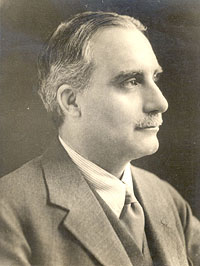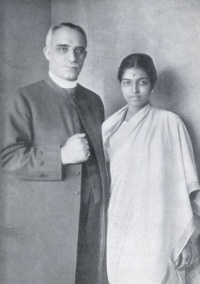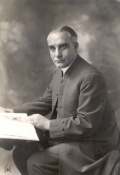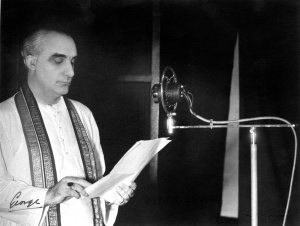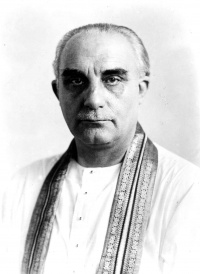George S. Arundale: Difference between revisions
No edit summary |
No edit summary |
||
| Line 4: | Line 4: | ||
== Early years and education == | == Early years and education == | ||
George Sydney Arundale was born on [[December 1]], 1878 in Surrey, England. His mother died at childbirth, and George was adopted by his aunt, [[Francesca Arundale]]. Miss Arundale joined the [[Theosophical Society]] in 1881 and often welcomed [[Helena Petrovna Blavatsky|Madame H. P. Blavatsky]] to her home. | George Sydney Arundale was born on [[December 1]], 1878 in Surrey, England. His mother died at childbirth, and George was adopted by his aunt, [[Francesca Arundale]]. Miss Arundale joined the [[Theosophical Society]] in 1881 and often welcomed [[Helena Petrovna Blavatsky|Madame H. P. Blavatsky]] to her home. George became a member in 1895 and joined the [[London Lodge]]. | ||
Young George attended schools in in Germany and in England, and in 1900 he was graduated from St John’s College, Cambridge. | Young George attended schools in in Germany and in England, and in 1900 he was graduated from St John’s College, Cambridge. | ||
== | == Early career as educator == | ||
Two years later, at Dr Besant’s invitation, he went to India with his aunt to become Professor of History at the [[Central Hindu College]], Benares (now Varanasi). In 1907 he was appointed Headmaster of the Central Hindu College School, and later Principal of the College. He was very popular with both teachers and students, for he had a great understanding of youth. | Two years later, at Dr Besant’s invitation, he went to India with his aunt to become Professor of History at the [[Central Hindu College]], Benares (now Varanasi). In 1907 he was appointed Headmaster of the Central Hindu College School, and later Principal of the College. He was very popular with both teachers and students, for he had a great understanding of youth. | ||
| Line 17: | Line 17: | ||
In 1920 Mr. Arundale married [[Rukmini Devi Arundale|Srimati Rukmini Devi]], the sixth child a very well-known Theosophical Brahmin family. The ceremony was conducted by Alladi Mahadeva Shastri.<ref>”Sarada Hoffman,” KutcheriBuzz Website www.kutcheribuzz.com/features/interviews/sarada.asp, accessed February 28, 2012. </ref> Rukmini Devi "was the first well-known Brahmin lady to break caste by marring a foreigner."<ref>Joseph E. Ross, ''Spirit of Womanhood,'' privately published by the author, 2009: vii.</ref> She and her family were ostracized by their Brahmin associates, but with support of Theosophists, the Indian public eventually adjusted to the marriage. She accompanied him on his worldwide lecture tours, and became well known to Theosophists in many countries. | In 1920 Mr. Arundale married [[Rukmini Devi Arundale|Srimati Rukmini Devi]], the sixth child a very well-known Theosophical Brahmin family. The ceremony was conducted by Alladi Mahadeva Shastri.<ref>”Sarada Hoffman,” KutcheriBuzz Website www.kutcheribuzz.com/features/interviews/sarada.asp, accessed February 28, 2012. </ref> Rukmini Devi "was the first well-known Brahmin lady to break caste by marring a foreigner."<ref>Joseph E. Ross, ''Spirit of Womanhood,'' privately published by the author, 2009: vii.</ref> She and her family were ostracized by their Brahmin associates, but with support of Theosophists, the Indian public eventually adjusted to the marriage. She accompanied him on his worldwide lecture tours, and became well known to Theosophists in many countries. | ||
Rukmini Devi gave an account of travel to England: | Rukmini Devi gave an account of travel to England: | ||
| Line 28: | Line 26: | ||
== Theosophical work == | == Theosophical work == | ||
[[File:George Arundale Seated.jpg|120px|right]] | [[File:George Arundale Seated.jpg|120px|right]] | ||
Beginning in 1910, Arundale frequently addressed Theosophical Conventions. After a brief period as General Secretary of the [[Theosophical Society in England]], 1915–16, he returned to India to assist Annie Besant in her political activities. | |||
In 1927 he undertook a lengthy lecture tour in Europe and the United States; Mrs Arundale and he were the guests of honor at the American Convention that year, and participated in the dedication of the headquarters building that was then being completed. Each year from 1931 to 1934, he undertook such lecture tours, greatly vitalizing the Theosophical work in the countries he visited."<ref>"George Sydney Arundale (1878 - 1945)," Theosophical Society, Adyar Web page. Available at [http://www.ts-adyar.org/node/80 Adyar Web page.]</ref> | In 1927 he undertook a lengthy lecture tour in Europe and the United States; Mrs Arundale and he were the guests of honor at the American Convention that year, and participated in the dedication of the headquarters building that was then being completed. Each year from 1931 to 1934, he undertook such lecture tours, greatly vitalizing the Theosophical work in the countries he visited."<ref>"George Sydney Arundale (1878 - 1945)," Theosophical Society, Adyar Web page. Available at [http://www.ts-adyar.org/node/80 Adyar Web page.]</ref> | ||
| Line 34: | Line 34: | ||
== Social activism and imprisonment == | == Social activism and imprisonment == | ||
Arundale became | Arundale became the Organizing Secretary of the All-India Home Rule League. He was interned, under house arrest, with [[Annie Besant]] and [[B. P. Wadia]], for three months in 1917, under the Defence of India Act, 1917. His official biography states, "From 1924 to 1926 he was President of the Madras Labour Union, which he had been instrumental in forming, and through which he successfully secured a higher minimum wage and less working hours for the working man."<ref>"George Sydney Arundale (1878 - 1945)," Theosophical Society Web page. Accessed [http://www.ts-adyar.org/node/80 Adyar Web page] on November 4, 2013.</ref> | ||
== General Secretary in Australia == | == General Secretary in Australia == | ||
| Line 47: | Line 47: | ||
== President of the Theosophical Society == | == President of the Theosophical Society == | ||
In this account of the Arundale presidency, | |||
<blockquote> | |||
When Dr Besant died in 1933, Dr Arundale was elected President of The Theosophical Society and began from 1934 to work out a Seven Year Plan which included the development of Adyar, and ensuring the solidarity of the Society. With well-prepared publicity material next year he launched a ‘Straight Theosophy’ Campaign, that encouraged the study of basic Theosophical principles, and culminated in the fine Diamond Jubilee Convention at Adyar in 1935. Lodges were urged never to forget their primary purpose of instructing members in Theosophy, using a language that could be understood. The next campaign was entitled ‘There is a Plan’. In 1935 three books of Dr Arundale in which he set forth his conceptions of human and spiritual values, were published: You; Freedom and Friendship and Gods in the Becoming. In 1936 he presided over the Fourth Theosophical World Congress at Geneva, when he decided the third Campaign should be for ‘Understanding’ which, proving successful, was extended into 1938. After that, ‘Theosophy is the Next Step’ was the theme, but the Second World War broke out and not much could be done. He then issued ‘Letters’ to Sections which were widely used and helpful. By 1936 there was a visible improvement in the membership of a number of National Societies, indicating that the President’s vigorous policy was taking effect. The Campaigns were creating new interest and activity. In 1937 Arundale gave a lecture on Symbolic Yoga at the Convention, using his material for ‘roof-talks’ at Adyar, and for his addresses later when on tour in Europe and America. These appeared as a book called The Lotus Fire: a Study in Symbolic Yoga. | |||
<br> | |||
<br> | |||
However, due to war conditions, travel outside India was not easy. The competent and devoted workers in every Section carried the Society forward under his direction. But all over Europe Lodge after Lodge and Section after Section was forced to close. Increasingly, Dr Arundale devoted himself to the inner side of the work in an endeavour to assuage the suffering of mankind. In an attempt to awaken people to a greater sense of responsibility, he started a small weekly paper in Madras called Conscience. He welcomed to Adyar Dr Maria Montessori and her son, Mario Montessori, who came to India but were unable to return to Italy because of the war. During their stay in Adyar, they trained teachers from India and neighbouring countries in the well-known Montessori method of child education. | |||
<br> | |||
<br> | |||
n 1940 Dr Arundale set up a Peace and Reconstruction Department so as to have a Charter for World Peace ready when the war ceased. Each year he stressed that members should spread ‘the mighty Truths of Theosophy’, undertook tours in India, and supported the art and educational institutions and activities of Rukmini Devi. He worked hard to build a better understanding on the part of Indians of the position of Great Britain in the West, and for a still more liberal attitude on the part of Great Britain towards India. In 1941 Dr Arundale was conferred the honorary degree of Vidyâ-Kalânidhi, meaning ‘Storehouse of Art and Wisdom’, by the old and much respected institution Shri Bharat Dharma Mahamandal, Benares (now Vârânasi), for his ‘extraordinary merits and excellent qualities’. Dr Arundale’s two special themes were: the unity of India and the development of greatness in the individual.<ref>"George Sydney Arundale (1878 - 1945)," Theosophical Society Web page. Accessed [http://www.ts-adyar.org/node/80 Adyar Web page] on November 4, 2013.</ref> | |||
</blockquote> | |||
== Co-Masonry == | == Co-Masonry == | ||
Revision as of 14:59, 4 November 2013
George Sydney Arundale (1878–1945) was an English Theosophist, educator, writer, and editor. He served as the third President of The Theosophical Society based in Adyar, India from 1934 to 1945.
Early years and education
George Sydney Arundale was born on December 1, 1878 in Surrey, England. His mother died at childbirth, and George was adopted by his aunt, Francesca Arundale. Miss Arundale joined the Theosophical Society in 1881 and often welcomed Madame H. P. Blavatsky to her home. George became a member in 1895 and joined the London Lodge.
Young George attended schools in in Germany and in England, and in 1900 he was graduated from St John’s College, Cambridge.
Early career as educator
Two years later, at Dr Besant’s invitation, he went to India with his aunt to become Professor of History at the Central Hindu College, Benares (now Varanasi). In 1907 he was appointed Headmaster of the Central Hindu College School, and later Principal of the College. He was very popular with both teachers and students, for he had a great understanding of youth. [1]
Marriage
In 1920 Mr. Arundale married Srimati Rukmini Devi, the sixth child a very well-known Theosophical Brahmin family. The ceremony was conducted by Alladi Mahadeva Shastri.[2] Rukmini Devi "was the first well-known Brahmin lady to break caste by marring a foreigner."[3] She and her family were ostracized by their Brahmin associates, but with support of Theosophists, the Indian public eventually adjusted to the marriage. She accompanied him on his worldwide lecture tours, and became well known to Theosophists in many countries.
Rukmini Devi gave an account of travel to England:
Dr. Arundale had a wide circle of friends in London. His father was a famous architect. I was told that he was invited by the Shah of Oman to renovate his Palace, since at that time, he was considered the best person to do it. The family was well known and they had many friends among the aristocracy and famous artists. Dr. Arundale himself was very popular. We stayed in the house of the Countess De la Warr and there were always people coming and going, garden parties, outings and shipping trips... Mr. Arundale took me to so many concerts and dances, we visited all the museums and art galleries and even among his friends, there were many great artists and painters. He used to play the piano very well, he could also compose music. He wanted me to see everything that the loved and appreciated in Western art.[4]
Theosophical work
Beginning in 1910, Arundale frequently addressed Theosophical Conventions. After a brief period as General Secretary of the Theosophical Society in England, 1915–16, he returned to India to assist Annie Besant in her political activities.
In 1927 he undertook a lengthy lecture tour in Europe and the United States; Mrs Arundale and he were the guests of honor at the American Convention that year, and participated in the dedication of the headquarters building that was then being completed. Each year from 1931 to 1934, he undertook such lecture tours, greatly vitalizing the Theosophical work in the countries he visited."[5]
Social activism and imprisonment
Arundale became the Organizing Secretary of the All-India Home Rule League. He was interned, under house arrest, with Annie Besant and B. P. Wadia, for three months in 1917, under the Defence of India Act, 1917. His official biography states, "From 1924 to 1926 he was President of the Madras Labour Union, which he had been instrumental in forming, and through which he successfully secured a higher minimum wage and less working hours for the working man."[6]
General Secretary in Australia
He became General Secretary in Australia, 1926, where, in addition to his Theosophical duties, he engaged in humanitarian and political work. He helped to set up the 2GB Broadcasting Station and became its first Chairman of Directors. He lived at The Manor and assisted Bishop Leadbeater in preparing that Theosophical center for its important future.
General Secretary in India
In 1928, Dr. Arundale became General Secretary in India, but he did not seek re-election.
President of the Theosophical Society
In this account of the Arundale presidency,
When Dr Besant died in 1933, Dr Arundale was elected President of The Theosophical Society and began from 1934 to work out a Seven Year Plan which included the development of Adyar, and ensuring the solidarity of the Society. With well-prepared publicity material next year he launched a ‘Straight Theosophy’ Campaign, that encouraged the study of basic Theosophical principles, and culminated in the fine Diamond Jubilee Convention at Adyar in 1935. Lodges were urged never to forget their primary purpose of instructing members in Theosophy, using a language that could be understood. The next campaign was entitled ‘There is a Plan’. In 1935 three books of Dr Arundale in which he set forth his conceptions of human and spiritual values, were published: You; Freedom and Friendship and Gods in the Becoming. In 1936 he presided over the Fourth Theosophical World Congress at Geneva, when he decided the third Campaign should be for ‘Understanding’ which, proving successful, was extended into 1938. After that, ‘Theosophy is the Next Step’ was the theme, but the Second World War broke out and not much could be done. He then issued ‘Letters’ to Sections which were widely used and helpful. By 1936 there was a visible improvement in the membership of a number of National Societies, indicating that the President’s vigorous policy was taking effect. The Campaigns were creating new interest and activity. In 1937 Arundale gave a lecture on Symbolic Yoga at the Convention, using his material for ‘roof-talks’ at Adyar, and for his addresses later when on tour in Europe and America. These appeared as a book called The Lotus Fire: a Study in Symbolic Yoga.
However, due to war conditions, travel outside India was not easy. The competent and devoted workers in every Section carried the Society forward under his direction. But all over Europe Lodge after Lodge and Section after Section was forced to close. Increasingly, Dr Arundale devoted himself to the inner side of the work in an endeavour to assuage the suffering of mankind. In an attempt to awaken people to a greater sense of responsibility, he started a small weekly paper in Madras called Conscience. He welcomed to Adyar Dr Maria Montessori and her son, Mario Montessori, who came to India but were unable to return to Italy because of the war. During their stay in Adyar, they trained teachers from India and neighbouring countries in the well-known Montessori method of child education.
n 1940 Dr Arundale set up a Peace and Reconstruction Department so as to have a Charter for World Peace ready when the war ceased. Each year he stressed that members should spread ‘the mighty Truths of Theosophy’, undertook tours in India, and supported the art and educational institutions and activities of Rukmini Devi. He worked hard to build a better understanding on the part of Indians of the position of Great Britain in the West, and for a still more liberal attitude on the part of Great Britain towards India. In 1941 Dr Arundale was conferred the honorary degree of Vidyâ-Kalânidhi, meaning ‘Storehouse of Art and Wisdom’, by the old and much respected institution Shri Bharat Dharma Mahamandal, Benares (now Vârânasi), for his ‘extraordinary merits and excellent qualities’. Dr Arundale’s two special themes were: the unity of India and the development of greatness in the individual.[7]
Co-Masonry
As a Co-Freemason, joining in 1902, he became, 1935, the Most Puissant Grand Commander, Eastern Federation, and Representative of the Supreme Council.
Liberal Catholic Church
In 1926, he became Regionary Bishop of the Liberal Catholic Church in India.
Other activities
"Dr Arundale was known not only for his Theosophical work but also for his interest in Co-Freemasonry, and the Indian Scout movement, being for some years Provincial Commissioner for Madras Province."[8]
Writings
Dr. Arundale wrote these books:
- Bedrock of Education. Adyar: Theosophical Publishing House, 1924.
- Thoughts of the Great. Adyar: Theosophical Publishing House, 1924.
- You. Adyar: Theosophical Publishing House, 1935.
- Gods in the Becoming. Adyar: Theosophical Publishing House, 1936.
- Education for Happiness. Adyar: Theosophical Publishing House, 1938.
- A Guardian Wall of Will: A Form of Tapas-Yoga. Available on Anand Gholap Web page.[4]
- Adventures in Theosophy. Adyar: Theosophical Publishing House, 1941.
- Kundalini: An Occult Experience. Wheaton: Theosophical Publishing House,??
- The Lotus Fire: A Study in Symbolic Yoga'. Wheaton: Theosophical Publishing House, ??
- Nirvana. Wheaton: Theosophical Publishing House, ??
- Occult Commentaries. Wheaton: Theosophical Publishing House,?? Audio recording of lecture on compact disk.
- The Way of Service, 1919. Available at [5]
In addition, he wrote over 2200 articles for Theosophical periodicals, being especially prolific during the years that he served as President and as editor of The Theosophist. To see a list, go to the Union Index of Theosophical Periodicals.
Later years
Dr. Arundale's official biographical notes on the Theosophical Society, Adyar Web page describe his last months:
"In 1945 he was advised complete rest for he was gravely ill, and despite all the care and attention given to him, he passed away on 12 August, just as the news that the world war had ended spread throughout the world. One of the finest contributions made to the Society’s work by Dr Arundale is best described by another slogan he invented — ‘Together Differently’. Repeatedly and insistently, he emphasized in his writings and talks that differences of outlook and opinion could only enrich the work of The Theosophical Society. Another important contribution was the emphasis he gave to straight Theosophy in the campaign which he initiated under that name. It cannot be said that any one of his contributions was more important than another, but the two mentioned above did unquestionably bring about a definite change in the minds and hearts of the membership, and sharply emphasized once more the freedom of individual thought inherent in Theosophical teachings. [9]
Rukmini wrote of his decline:
From 1942 onwards Dr. Arundale's health had been slowly deteriorating. He was such an uncomplaining, cheerful person that I never knew how seriously ill he was. he was highly diabetic but because of his principles would not take medicines which were produced by killing animals. I would pester him to come with me on my dance tours never realizing what a great effort he was making to please me. He passed away in 1945. Till the last moment I was so sure that he would be cured. He had always been there to take care of things but he was also preparing me in many ways - I can see it now - to stand on my own.[10]
Mrs. Arundale traveled to Haridwar and Rishikesh to immerse his ashes.[11]
Notes
- ↑ "George Sydney Arundale (1878 - 1945)," Theosophical Society, Adyar Web page. [1]
- ↑ ”Sarada Hoffman,” KutcheriBuzz Website www.kutcheribuzz.com/features/interviews/sarada.asp, accessed February 28, 2012.
- ↑ Joseph E. Ross, Spirit of Womanhood, privately published by the author, 2009: vii.
- ↑ Rukmini Devi Arundale, "Rukmini on Herself," Rukmini Devi Arundale: Birth Centenary Commemorative Volume, Shakuntala Ramani, ed., (Chennai, India: The Kalakshetra Foundation, 2003), 26.
- ↑ "George Sydney Arundale (1878 - 1945)," Theosophical Society, Adyar Web page. Available at Adyar Web page.
- ↑ "George Sydney Arundale (1878 - 1945)," Theosophical Society Web page. Accessed Adyar Web page on November 4, 2013.
- ↑ "George Sydney Arundale (1878 - 1945)," Theosophical Society Web page. Accessed Adyar Web page on November 4, 2013.
- ↑ "George Sydney Arundale (1878 - 1945)," Theosophical Society, Adyar Web page. [2]
- ↑ "George Sydney Arundale (1878 - 1945)," Theosophical Society, Adyar Web page. [3]
- ↑ Rukmini Devi Arundale, "Rukmini on Herself," Rukmini Devi Arundale: Birth Centenary Commemorative Volume, Shakuntala Ramani, ed., (Chennai, India: The Kalakshetra Foundation, 2003), 64.
- ↑ Ibid., 64
Additional resources
- The Theosophist, Vol. 66, No. 12, September 1945 (Commemorative Issue).
American Section, study course on Theosophy and Theosophical Society (Theosophical Society Archives).
- Dixon, Joy, Divine Feminine: Theosophy and Feminism in England (London: John Hopins, 2001)
- Lutyens, Mary, Krishnamurti: The Years of Awakening (London: John Murray, 1975)
- Lutyens, Mary, The Life and Death of Krishnamurti (London: John Murray, 1990)
- Meduri, Avanthi (ed.), Rukmini Devi Arundale (1904-1968): A Visionary Architect of Indian culture and the Performing Arts (Delhi: Motilal Banarsidass, 2005)
- Ransom, Josephine. The Seventy-Fifth Anniversary Book of the Theosophical Society. Theosophical Publishing House, 2005.
